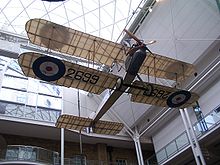- Aircraft dope
-
Aircraft dope is a plasticised lacquer that is applied to fabric-covered aircraft. It tautens and stiffens fabric stretched over airframes and renders them airtight and weatherproof.[1]
Typical doping agents include nitrocellulose, cellulose acetate and cellulose acetate butyrate. Liquid dopes are highly flammable; nitrocellulose, for instance, is also known as the explosive propellant "guncotton". Dopes will often include colouring pigments to facilitate even application. The colour will usually be red or silver.[citation needed]
Dope has been applied to various aircraft fabrics but typically to Madapolam or fabric with similar fine weave and absorbent qualities. In model aircraft it is often applied to tissue paper.[citation needed]
Non-shrinking dopes (eg banana oil) also exist for uses where tautening is undesirable.[citation needed]
Accidents
Accidents have occurred when dope is not used correctly, for example when mixed with other chemicals, used on the wrong fabrics or applied to contaminated or improperly prepared surfaces.
- On 27 April 1995 91-year-old aircraft designer and builder Steve Wittman and his wife were killed when their Wittman O&O Special broke up in flight due to delamination and separation of the wing fabric, resulting in wing aeroelastic flutter. The US National Transportation Safety Board stated in their investigation report: "A small section of the wing wood and fabric material was removed for examination. "The examination disclosed that the mahogany plywood had been coated with clear Nitrate Dope". Next, the builder covered the plywood with Stits 150 pound poly-fiber. The builder next brushed a coat of nitrate dope over the layer of poly-fiber followed by a clear coat of butyrate dope. Finally, several coats of poly-spray and yellow poly-tone were sprayed over the coat butyrate dope. According to Mr. Ray Stits, President of Stits Aircraft, the above stated process does not provide the best adhesive qualities. The builder should have first applied two coats of poly-brush on the bare plywood, (see the Poly-Fiber Covering and Painting Manual)."[2][3]
References
- ^ Crane, Dale: Dictionary of Aeronautical Terms, third edition, page 170. Aviation Supplies & Academics, 1997. ISBN 1-56027-287-2
- ^ National Transportation Safety Board (December 1995). "Brief of Accident". http://dms.ntsb.gov/aviation/GenPDF.aspx?id=ATL95FA092&rpt=fi. Retrieved 27 August 2011.
- ^ National Transportation Safety Board (April 1995). "NTSB ID: ATL95FA092". http://dms.ntsb.gov/aviation/GenPDF.aspx?id=ATL95FA092&rpt=fi. Retrieved 27 August 2011.
Lists relating to aviation General Aircraft (manufacturers) · Aircraft engines (manufacturers) · Airlines (defunct) · Airports · Civil authorities · Museums · Registration prefixes · Rotorcraft (manufacturers) · TimelineMilitary Accidents/incidents Records Categories:- Aircraft skin
- Coatings
Wikimedia Foundation. 2010.

